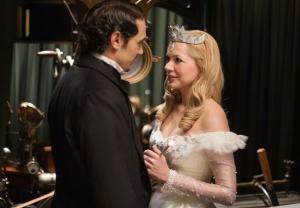Irresistible magic creeps into ‘Oz’
There is much to be skeptical about with “Oz the Great and Powerful.” It wears its similarities to its cousin “Alice in Wonderland” on its sleeve (even the poster designs featured a strikingly similar set design). It’s out to tinker with an enduring, much-loved family classic. The last time director Sam Raimi was left with a budget this big, the result was “Spider-Man 3,” and it's from the same studio (Disney) that promised us much big-screen spectacle this same time last year with “John Carter,” whose failure is now the stuff of cinema legend.
And yet with all these elements working against it, there is a certain irresistible magic that creeps in, and, much like Oz himself, the film wins us over in its favor by the end credits.
“Oz” lands us in Kansas in 1905, where crappy carny magician Oscar “Oz” Diggs (played by James Franco) puts more effort into getting ladies back to his room than he does his failing act. He puts the “parlor” in parlor tricks.
Upon being chased out of town, Oz winds up getting sucked into one of those infamous Kansas twisters and plopped into a land bearing his name. He is informed by the lovely Theodora (played by Mila Kunis), that his arrival was foretold and that he was to save them from the tyranny of the Wicked Witch. All Oz hears is the substantial riches he will inherit.
Oz assembles his own ragtag group of misfits for this yellow brick trek, joined by Finley, a winged, talking monkey in a bellhop uniform (because the only thing cuter than a monkey with a bellhop uniform is one with wings on it), an anthropomorphic China doll, and a young Glinda the Good (played by Michelle Williams). They all join forces in order to save the Emerald City and its denizens, many of whom you may recall from the original film, but a slew of new ones that get too few minutes on screen.
From the opening scenes, you can witness the loving shout-outs not only to the original (it begins in black and white before exploding into vibrant color), but a celebration of illusions in their many forms (be they on the stage, on the screen or in the flesh). It’s a thematic element of “Oz” that should be credited to the talents of its director Raimi. He packs the film with odes to moviemaking that audiences, especially those with a knowledge of film, soak in throughout the journey.
For example, not only does the film begin in black and white, but also in the original, square-like, 4:3 Academy ratio. Later, in the city, we meet The Tinkerers, elderly bearded men who resemble the group of scientists from 1902’s “La Voyage dans la Lune,” one of the very first films to feature special effects. The film is also filled with shout-outs to Edison, early motion-picture devices and an honest love for the art that Raimi infuses throughout.
This makes up for the ill-fated decision to have Franco play the lead. Perhaps they were hoping to catch the whole Johnny Depp vibe (who was rumored to have been considered) of casting an eccentric slacker-hero as the lead, but Franco is oddly restrained here and is too quick to rely on his mile-wide grin rather than actually dig in and get as freaky as Depp is capable of doing. And while Kunis has earned much-deserved credit for her recent roles in “Ted” and “Black Swan,” here she seems out of her element. While she looks great in her Prince-meets-Puss-in-Boots outfits, she never immerses herself in her character as do her costars Michelle Williams as Glinda and Rachel Weisz as the eldest witch sister Evanora.
Both Williams and Weisz seem to fully understand the film’s tone and sensibilities.
For those who nostalgically pine for the original, this is not your great-grandmother’s “Oz.” Remember, Raimi cut his teeth in the dark forest of horror with the “Evil Dead” series, so there is a prevalent sense of dread throughout (yes, even though they are pixellated, those flying monkeys can still scare the hell out of you).
But even more importantly, there is Raimi’s admiration of the art of filmmaking that looms over “Oz” like some large omnipresent floating head that helps take attention away from the some of the smaller messes behind the curtain.















































